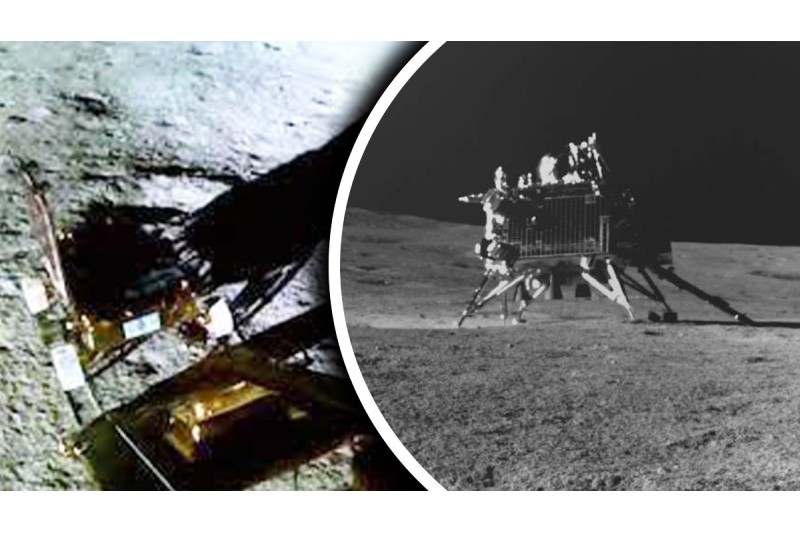Moon Dust was hardly Stirred up by India’s Chandrayaan-3 Lunar Lander. This is why it is Relevant

Thanks to a special arrangement of engines, India’s Chandrayaan-3 spacecraft, which made a flawless landing close to the moon’s south pole in August, hardly produced any dust during descent, according to a recent research. The spacecraft was able to avoid dangerous craters and make a safe landing because its cameras were able to get a clear view of the landing area in the crucial minutes before touchdown.
According to Suresh K, a scientist at the Space Applications Centre (SAC), a research facility of the Indian Space Research Organization (ISRO) in Gujarat, India, “the scientifically interesting areas are always the hazardous regions] when you’re heading [to the south pole].”
Speaking on Monday, March 11, at the Lunar and Planetary Science Conference (LSPC), taking place in Texas this week, K presented pre- and post-landing images from the mission to scientists. The mission ran for two weeks on the moon before, predictably, collapsing due to extremely cold lunar night temperatures.
Spacecraft use their engines to slow down during descent in order to prepare for a gentle landing. The moon’s low gravity and absence of atmosphere cause the regolith, which resembles powder, to usually blast into a massive plume when the exhaust from these engines reaches the surface.
However, the resulting dust plume was visible to Chandrayaan-3 spacecraft cameras starting at a mere 59 feet (18 meters) above the lunar surface. According to K, this is the least amount of moon dust that has ever been released on a moon landing, including NASA’s Apollo missions and China’s Chang’e-3 undertakings.
The lander named Vikram (Sanskrit for “valor”) and a high-resolution camera on board the Chandrayaan-2 orbiter, which has been orbiting the moon since its lander-rover pair crashed during touchdown in 2019, were the sources of the pre- and post-landing images of the touchdown area that he and his colleagues examined. A camera on the rover Pragyan (Sanskrit for “wisdom”) confirmed that the dust that was discharged after Vikram’s touchdown covered an area of roughly 1,561 square feet (145 square meters) surrounding the lander. This indicates that far more than 4,500 pounds (2 metric tons) of lunar regolith would have been displaced by the spacecraft, as opposed to earlier estimations of 1,167 square feet (108 square meters).
K explained the intriguingly brief dust plume at LPSC on Monday, citing the spacecraft’s lack of a central engine as the cause of the decreased engine thrust during descent. When the spacecraft reached 0.4 miles (0.8 kilometers) above its intended landing area, it turned off two of its four 800-newton engines, leaving two diagonal engines running until touchdown. The spacecraft began its “rough braking phase” at an orbit of 18.6 miles (30 kilometers) above the lunar surface. The engine employed on the expedition was the “least powerful till date,” according to K. “We’ve observed very less disturbance on the surface.”
Apart from the engines working in a diagonal orientation, the mass of the spacecraft and the surrounding regolith qualities also affected the height of the plume. K informed scientists at LPSC on Monday that the Chandrayaan-3 mission team is still reviewing the data on that front and plans to provide it to the public in two months.
Indian Prime Minister Narendra Modi dubbed the landing spot the Shiv Shakti Point (Sanskrit for “power” and “Shiva” respectively), and during their two weeks there, Vikram and Pragyan achieved a number of goals. The International Astronomical Union (IAU), which is in charge of formally naming celestial bodies and their characteristics, has not yet approved the name.
According to Pratim Das, the head of ISRO’s science program office in Bengaluru, by moonset, the Pragyan rover had covered 331 feet (101 meters) on the lunar surface, found sulfur on the moon, had to reroute after encountering a potentially fatal crater, and had sampled lunar regolith at seven or eight locations.
According to him, the seismometer aboard Vikram also recorded a number of “naturally occurring events” on the moon, including as micrometeorite impacts and moonquakes, the investigation of which is still ongoing. First, an onboard thermal probe was lowered 4 inches (10 cm) or so into the surface to measure the temperature of lunar soil at various depths.
Now that the Chandrayaan-3 mission is history, India is preparing for the moon with Chandrayaan-4, which is expected to launch in 2028 and bring lunar rocks to Earth. In the past, Modi stated that the nation should strive to send a man to the moon by 2040. However, neither ISRO nor its partner organizations have disclosed specifics about how they intend to carry out this goal.